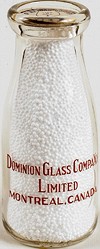
Demiard - Denis Morin
Dominion Glass Company Limited
(1913... )

Demiard - Denis Morin
Historique
Traduction française à suivre...
Between 1825 and the turn of the century, a number of glass works were built in Canada and operated for longer or shorter periods depending on the supply of capital, which was rarely excessive.
Those hardy enough to survive were the companies that eventually were merged into one large corporation - today's Dominion Glass Company Limited. The oldest of them was the Foster Brothers Glass Works, set up in St. Johns, Quebec, in 1855 and purchased in 1880 by a group of Montreal businessmen headed by William and David Yuile. The Yuiles, who moved the firm to Montreal, were innovators, and led in the transition from hand operations to automatic glassmaking machinery.
In 1890 they changed the name of their company to Diamond Glass Co. (Ltd.), absorbed four glass companies located as far apart as Nova Scotia and Hamilton, Ont., and continued a vigorous program of expansion. The name was changed again in 1903, this time to Diamond Flint Glass Company, other companies were absorbed, and in 1906 a subsidiary, The Canadian Glass Company, was opened in Montreal and entirely equipped with automatic bottle-making machines. Still another factory was established in 1913 in Redcliff, Alberta, to take advantage of the plentiful supply of natural gas.
The present day organization, Dominion Glass Company Limited, was formed in 1913. It incorporated the Diamond Flint factories in Montreal, Toronto, Hamilton and Redcliff, Canadian Glass in Montreal and Sydenham Glass in Wallaceburg, Ontario, the Manitoba Glass Company and the majority stock of the Jefferson Glass Co. in Toronto.
The Glass Division now consists of factories at Montreal, Hamilton, Wallaceburg, Redcliff, Alta. and Burnaby, B.C. In 1962 the company added a Plastics Division in Etobicoke, Ontario, to offer a greater diversity in its line of containers.
From the viewpoint of the historian, Dominion Glass Company Limited is one of the few active Canadian manufacturing establishments which may authoritatively claim to have provided a major contribution to the Canadian decorative arts. Indeed, any and all glass objects, including containers, which were produced in the preceding and extant glass factories during the period 1855-1925 have some claim to artistic beauty, rarity and/or social significance. The free blown, non-commercial glass paperweights, whimsy bird forms and "drapes" which were produced to exhibit an individual command of the medium, depict in three-dimensional form the ethnic and regional origins of specific glass blowers. The commercial containers (i.e., bottles and preserving jars) changed the Canadian housewife's concept of preserving foods and are presently acquired by discriminating collectors and exhibited in the Royal Ontario Museum.
From the technical viewpoint, the era which encompassed an unbroken continuity of ownership included techniques which originated in antiquity and ended with modern and total mechanization. The blowpipe, the pontil rod, the twopiece hand-operated mould, and eventually, the technological mass production of the twentieth century are all included in the growing up of Dominion Glass Company Limited.
From the aesthetic viewpoint, the Burlington Glass Works of Hamilton Ontario (1875-1901), acquired by Diamond Glass Company Limited 1891) provided the Canadian researcher with a new dimension and appreciation of the potential which is inherent in our decorative arts. All too seldom does the recorder of facts accept the premise that our early artisans were not inept, and all too often have we considered our forefathers to have been second-rate and mediocre.
The Burlington Plant of Diamond Glass refuted such concepts and recent discoveries prove that forms and formulae hitherto credited to other sources were produced and designed in Canada.
Source et recherches : Paul Huntley